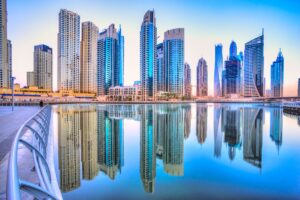Back to: English Language Primary 5
Welcome to class.
ADVERBS
Adverbs tell us how, when, where, how much, how often something happened or an action was performed. An adverb tells us more about a verb by modifying or describing it in some ways. An adverb also modifies an adjective and another adverb.
One of the ways to identify adverbs is that they end with -ly.
Let us see some adverbs…
Kindly… The woman treated me kindly.
Kindly here is an adverb that was formed by adding -ly to the adjective “kind.”
Let us do the same with polite, quick, cheerful, positive, grumpy.
The little girl speaks politely.
Please quickly do the laundry.
Cheerfully, I danced to my room.
“It’s over there”, she said grumpily.
The crowd positively responded to the artiste.
Note that adverbs can appear at the beginning, middle or end of a sentence.
COMPREHENSION
THE CITY OF DUBAI


Cities do not just appear overnight. From an early settlement to a huge mega city, it can take hundreds, sometimes thousands of years. There are, however, exceptions and one such city is Dubai, which is on the south-east coast of the Arabian Gulf.
Less than 200 years ago, Dubai was a settlement at the mouth of a creek on the edge of the desert. Today, it is the capital city of the United Arab Emirates (UAE), with a population of over two and a half million people.
In 1833, 800 members of the Bani Yas tribe- led by the Maktoum family- settled at the mouth of a creek on the coast of the Arabian Gulf. The creek provided a natural harbor and the settlement soon became a center for fishing, pearl diving and sea trade.
In the early 20th century, Dubai was a successful port. The souk on one side of the creek had 350 shops, as well as numerous visitors and traders. By 1930, a little over a hundred years since the first settlers, the population was 20,000.
It seemed that Dubai would keep expanding but, in the 1950s, a huge problem arose. The creek began sitting up. Ships could not easily get into the harbor and trade was threatened. The leader Sheikh Rashid bin Saeed Al Maktoum, ordered that the creek should be dredged, a process to remove the silt. This was a difficult task but a successful solution to the problem, making Dubai the major trading port in the area.
Dubai’s rapid expansion was helped by the discovery of oil in 1966. The money from oil sales was spent on improving infrastructure. Schools, hospitals and roads were built. The airport and its runaways were expanded so that any international aircraft could land there. The world’s largest man-made harbor (at Jebel Ali) was created.
By the 1980s and 1990s, Dubai’s aim was to become a major tourist center. Luxurious hotels were built, such as Burj Al Arab. The city held major sporting events in tennis, golf, horse racing and rugby.
In 2010, the Burj Khalifa was completed. It is the tallest man-made structure on Earth with 163 storeys rising almost 830 metres in the sky. It gives spectacular views over the city and out across the deserts. So, from its humble beginnings on the egde of the creek and surrounded by desert, Dubai has grown to become the city we see today.
QUIZ
Answer the questions about this passage by filling in the missing words in each sentence.
- Dubai is on the south-east—————–of the Arabian Gulf.
- The creek provided a natural ———–.
- The ——————– had 350 shops.
- When the creek began———————–, the ships couldn’t easily get into the harbor.
- The Burj Al Arab is a ———————-hotel
Tell us, why do you think Dubai wanted to become ‘a major tourist center?’
VOCABULARY DEVELOPMENT.
Let us learn some new words from the passage we just read. Always remember that a word might have more than a meaning. However, when it comes to passages, the meanings of words are according to context. This means we will choose a meaning for a word with regard to the passage or sentence in which the word was used; the environment surrounding the word.
Settlement… A small community, village, or group of houses in a thinly populated area.
Exceptions… Things that do not follow the rule.
Numerous… Many
Infrastructure … The basic physical and organizational structure and facilities(e.g buildings, roads, power supplies) needed for the operation of a society or enterprise.
Luxurious… Expensive and comfortable.
INTONATION IN COMMAND
Falling intonation is used for asking and giving information in normal, quiet style. At the same time, falling intonation conveys certain emotions, such as completion, finality, confidence. Falling intonation sounds more categorical, confident, and convincing than rising intonation.
It is the Falling intonation that is used in Commands.
Remember that a Command is always given by a superior, elderly one, teachers, etc. to a student, child, etc. An example is when your teacher says, “John, SIT!” What would you? You obey and sit.
Other examples are:
Shut the DOOR!
Leave that room at ONCE!
Shut your MOUTH!
Note that the intonation falls on the last word in the sentence.
